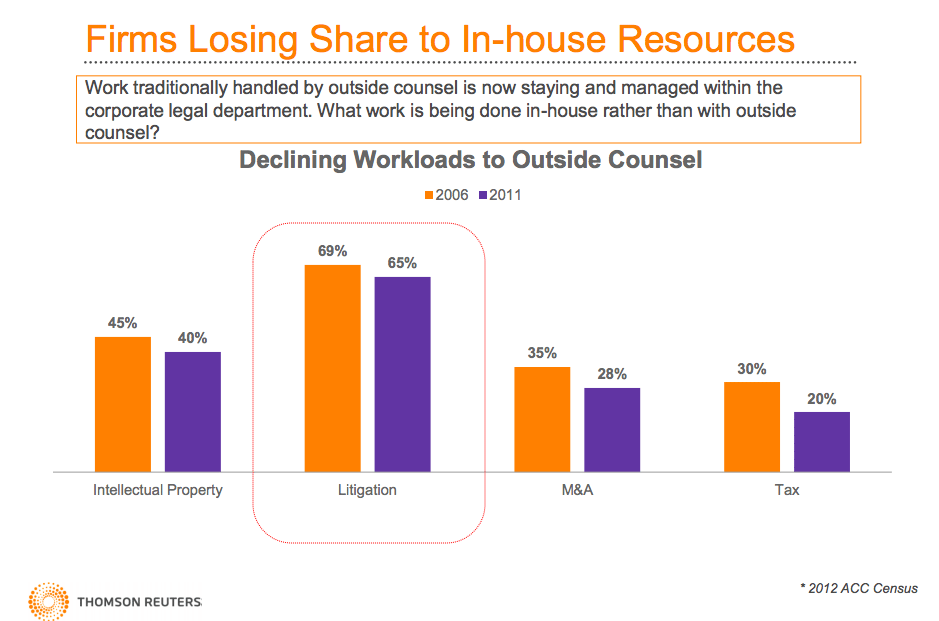In January, I spent three stimulating days at the Thomson Reuters Legal Executive Institute’s Marketing Partner Forum in Naples, Florida. After 12 months of listening to much on-line prognosticating about the demise of BigLaw (and life as we know it, evidently) we heard numerous panels of managing partners, marketing partners, in-house counsel and CMOs who shared inside baseball tips on their successful efforts to innovate and prosper in a changed marketing environment for legal services.
Here are four recurring themes from the conference that got me thinking — and working out how we’ll use these concepts and ideas for our clients.
1. Peer Monitor, which draws economic data directly from 175 law firm accounting departments, was recently purchased by Thomson Reuters (conference sponsor and my publisher). Thomson’s economist, Mark Medich, shared the highlights of the 2013 analysis in the conference keynote. Highlights include:
- Demand for legal services in 2013 was a soft year and was (on average) flat, but not for everyone. In fact, last year averages were less meaningful than ever because of the differences between firms.
- The firms that are thriving are a smaller handful, and more firms switched into negative growth mode between 2012 and 2013, a trend that began with the recession in 2008.
- Interestingly, while the projections for 2014 don’t look any better than 2013 on average, managing partners express a fairly positive sentiment. Things might not look good, but they’re feeling hopeful.
- Participating Peer Monitor firms identified growth practices as IP, real estate, corporate, litigation.
- Finally, Mark reminded us that demand for legal services is not ACTUALLY down; in fact, demand for legal services in general is growing. It’s how that demand is being met that has changed. Corporations are meeting their legal needs by increasingly keeping legal work in-house (69% was outsourced in 2006; in 2012 that dropped to 65%), some work is going to firms in local jurisdictions outside the U.S. (rather than hiring a law U.S. firm to handle the matter) and of course non-traditional providers like Axiom and LPO are gaining acceptance and market share.
2. Ten years ago law firms toyed with deploying client teams. To hear them tell it, they explored in detail how to do it wrong. Now firms have got it down and a number of marketing and managing partners on different panels shared the Cliff’s Notes on doing it right.
- Key client teams must been selectively staffed (5-8 lawyers, not a cast of thousands).
- They must be staffed from an admin AND a bizdev or marketing perspective.
- Don’t launch too many key client teams (try 5, not 20, even if your firm is 1500 lawyers).
- This is about genuine alignment with the client – genuine desire to serve them better – and only secondarily about increased revenue.
- The client should be in on the secret.
- Firms who spoke at MPF saw their key clients yield 20% higher revenue than comparable clients.
3. The nextgen of client teams is educating the firm’s lawyers on their client’s business. Not aspects of a client’s business that will lead to increased hours or matters, but actually understanding more about, for instance, the business realities of running a hospital or what it means to effectively manage a software company in today’s technology landscape. The lawyer education the speakers described was off-the-clock, in-depth and conducted with the client’s knowledge. I heard this on numerous panels on numerous topics.
Of course, it is a bit crazy that this is news, delivered by a managing partner, at a respected conference. Why do law firms hire me? Their confidence is not built on my ability to develop sales strategies. They only sit up and pay attention when I demonstrate that I understand practices of law, how those practices are marketed, the market forces that govern those practices and the trends that drive demand up or down. But this is the first I’ve heard that they would return the favor to their clients.
4. Another area in which CMO and MP presenters were painfully honest was lateral hiring. Several years ago The McCormick Group released a report that said the cost of acquiring, compensating and integrating a lateral was $600K. And they estimated that 60% of laterals fail. According to several Am Law 200 firms whose management presented at MPF, that is an optimistic number.
But the point of their presentations was what they are doing to improve the success rate.
- Rigorous and thoughtful interviewing of the potential lateral to understand the true make-up of their portable book is crucial. Sample questions include: Is that client your brother-in-law? Does that client use your current firm in 10 areas of law (implying they won’t come to us if just you leave); did you inherit that client or bring them home yourself?
- “Your people will be my people.” Speakers drove home that successful lateral integration doesn’t mean that the lateral needs to figure it out and integrate into the company culture alone. Goulston and Storrs’ CMO mentioned the firm’s 18-point “Roles and Responsibilities” that details what is expected of partners within the firm to ensure the lateral is successful. And meetings are had where the 18 points are discussed to ensure that the firm truly “walks the walk.”
- Another firm talked about their ‘integration task force’ which is set up for every lateral.
- Groups of laterals seem to be stickier, i.e. more of them work out than singles.
- Most firms rarely bring in equity partners. Rather, equity is bestowed after an 18-month or 2-year probation period. Except of course, when equity is the only way to get a highly desirable lateral. But exceptions seem rare.
- The integration of new clients that come with the lateral is also a very deliberate process that involves a lot of off-the-clock education, work and visits by the new ‘host’ firm. Most laterals welcome this, but others want time to make themselves at home in the new firm before ‘mass meeting’ with their clients.
Other themes that were explored were: (1) client interviews are very valuable and an almost universal best practice, which is good news for the folks at Wicker Park and LawVision’s new partner Marcy Borgal-Shunk, whom I met at the conference. (2) Our in-house GC clients live with steadily increasing pressure from their internal clients for price predictability. It’s not fun to be viewed as a necessary evil or an “expense” rather than someone who contributes to the bottom line and we need to be sensitive to their position. (Bizdev and marketing professionals can probably help their lawyers understand how this feels.)


